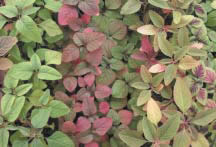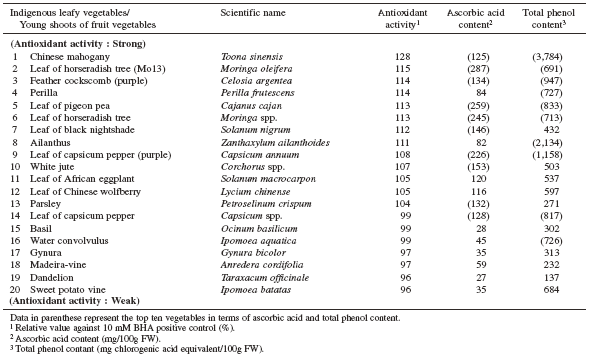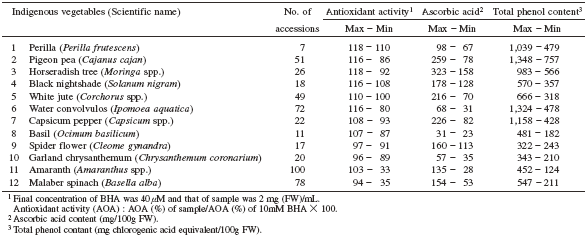Evaluation of antioxidant activity of indigenous vegetables from South and Southeast Asia
Description
[Objectives]
More than eight hundred million people currently suffer from hunger and malnourishment. Improving the production of principal food crops such as rice, wheat, corn and root crops has thus become one of the most important research subjects in the field of agriculture. Yet, sufficient levels of micronutrients and vitamins are also essential for maintaining good health, especially for pregnant women and preschool children in rural areas. Since vegetables can provide high levels of micronutrients, vitamins and fiber, producing more vegetable varieties has become an important task. To help develop vegetable variety, indigenous vegetables that are under-utilized globally but sufficiently adopted to local areas in growth and taste preferences (Fig. 1) can be of great value. The purpose of this study, conducted in collaboration with the Asian Vegetable Research and Development Center (AVRDC), has been to select the most superior indigenous leaf vegetables based on functional properties.
[Results]
To complete this objective, various accessions of indigenous vegetables from South and Southeast Asia were evaluated for their antioxidant activity, levels of ascorbic acid (vitamin C), and total phenol count. Antioxidant activity was assayed by a modified thiocyanate method using ethanol extracts; total phenolic compounds were determined by the Folin-Denis method using the same ethanol extracts; and ascorbic acid content was evaluated by RQflex and use of analytical test strips. These methods do not require the use of expensive analytical instruments such as high performance liquid chromatography (HPLC).
Among the twenty tested vegetable varieties, the top nine were determined to have young shoots and leaves with extremely strong antioxidant activity. These include Chinese mahogany (Toona sinensis), Horseradish tree (Moringa spp.), Feather cockscomb (Celosia argentea), Perilla (Perilla frutescens), Pigeon pea (Cajanus cajan), Black nightshade (Solanum nigrum or S. americanum), Ailanthus (Zanthoxylum ailanthoides), Capsicum pepper (Capsicum annuum) and White jute (Corchorus spp.). These vegetables also had a tendency to have higher ascorbic acid and total phenol contents (Table 1). Antioxidant activity, ascorbic acid and total phenol contents differed not only among vegetable species but also among accessions (Table 2).
For the selection of superior indigenous vegetables, evaluation of antioxidant activity, ascorbic acid and total phenol contents can be used as a novel index together with morphological and ecological characterization, and yield evaluation.
Figure, table
-
Fig. 1. Genetic diversity of Amaranth or Chinese spinach (Amaranthus spp.). -
Table 1. The highest rated indigenous leafy vegetables in tems of antioxidant activity, ascorbic acid and total phenol contents at the AVRDC.
-
Table 2. Diversity of antioxidant activity, ascorbic acid and total phenol contents in young shoots and leaves of indigenous vegetables from South and Southeast Asia.
- Affiliation
-
Japan International Research Center for Agricultural Sciences Biological Resources Division
- Classification
-
Technical A
- Term of research
-
FY2002 (FY2000-2002)
- Responsible researcher
-
SATO Takanori ( Biological Resources Division )
Engle Liwayway M. ( Asian Vegetable Research and Development Center )
- ほか
- Japanese PDF
-
2002_05_A3_ja.pdf872.58 KB
- English PDF
-
2002_05_A4_en.pdf58.49 KB



